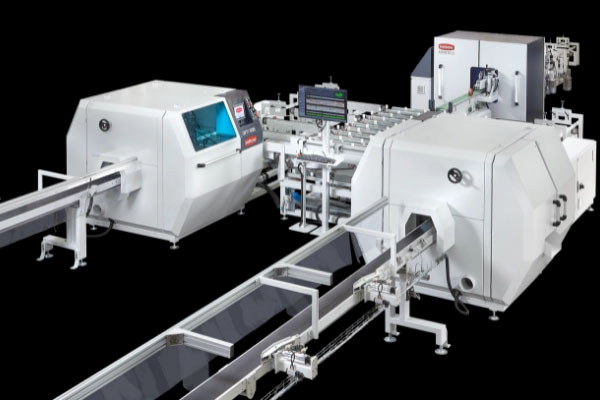Industrial sawmills have come a long way in recent years. The rise of automation and computer controlled sawmill machinery has allowed manufacturers to produce higher quality products more efficiently than ever. In this article we’ll go over the three major stages of lumber processing and the equipment used by sawmills at each stage.
- Raw Lumber Milling
The first stage of the sawmilling process involves transforming raw lumber into usable lengths. Lumber arrives from logging camps as sawn logs, typically with bark and any defects still attached. The sawmill accepts these logs and uses three main types of machinery to cut them into saleable pieces:
- Debarking Machines. New logs are run through a debarking machine that removes bark, branch stubs and cambium – the soft outer layer of timber. These outer layers are no use as construction timber, and they’re removed to allow each piece of lumber to be accurately measured and graded.
- With its bark removed, a log will pass onto the grading process. At this point a worker will measure and mark the log to determine how it can be processed into planks. This process is sometimes handled by computer controlled machinery. Once the cuts are marked, the log is placed into the cradle of a large bandsaw. The bandsaw begins by removing outer layers to create flat, smooth faces that can be used as registration points. From there, the bandsaw divides the lumber into planks, taking into account grain direction, the presence of knots and other defects.
- Drying Kilns. Sawn planks aren’t quite ready for use. Because logs are processed while they’re still green, the planks need to be allowed to dry prior to use. Some sawmills may place sawn planks in the sun and allow them to air dry over several weeks or months. Others use industrial kilns to fire the timber and drive out excess moisture.
-
Timber Processing
In some cases, the sawmilling stops here, and the sawn planks are passed onto other manufacturers for processing and refinement. This creates additional handling, but it allows manufacturers the most freedom to develop products their customers want. More commonly though, the sawmill will keep the sawn planks on site, using specific machinery to turn them into retail products:
- Docking Saws. Docking saws are industrial-scale crosscut saws that rapidly cut sawn planks down to size. These machines are often coupled with computer monitoring technology that automatically marks defects and determines where to cut for the greatest efficiency. Docking saws may be used to create timber pieces of any size, with the waste being removed and processed down into wood chips, firewood or other byproducts.
- Finger Jointers. Waste is a major concern in sawmilling. Because defects such as knots typically need to be removed, large planks may yield very few useful pieces of timber. To combat this problem, sawmills have begun using finger jointers to transform undersized or unusual pieces of timber into engineered wood. Finger jointers cut matching joints into lengths of timber that allow them to be joined together, creating a strong piece of wood that can be used for things like benchtops, furniture and moulded products.
- Automation Equipment. Sawmills rely on automation equipment to boost production speed and efficiency. Modern automation solutions greatly improve processing speeds and reduce the amount of labour invested into each stage of production. This allows workers to focus their efforts in more important areas while robots take care of menial and repetitive tasks.
-
Product Refinement
Finally, the processed timber can either be sold as-is, or it may pass through a final refinement step. Some sawmills perform additional refinement to add value to their products. This can be done in a number of ways, but the most common sawmill machinery includes:
- Moulders are industrial-scale routers that automatically cut shapes and profiles into lengths of timber. These can be used to create anything from cornices to skirting strips, dressed timber, tongue and groove joints, carved profiles and more. Moulders are often a worthwhile investment for sawmills, as they can transform finger jointed lengths into high-value products that are worth more than simple pieces of construction timber.
- Sanders are used to smooth the surface and remove any obvious tooth marks left over from the milling process. While it’s uncommon to sand or surface construction timber, retail products like laminated timber boards often undergo multiple rounds of sanding to ensure a high quality surface finish.
- End Matchers. End matchers are dedicated machines designed to create tongue and groove joints. These are especially common in the flooring industry, where hardwood products are turned into click-lock floors. End matching lines are uncommon in the sawmilling process, but many mills have their own refinement factories that may handle this type of task.

